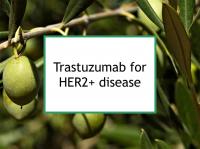The current webpage is designed to make additional research available concerning how various foods and food components enhance treatment with trastuzumab (Herceptin). At the bottom of this webpage are links to studies relating to the beneficial foods listed in Foods to eat & avoid during trastuzumab treatment.
Foods and their compounds enhance trastuzumab treatment or help protect against its adverse side effects (without reducing efficacy) through the actions of certain polyphenols, omega-3 fats, the hormone melatonin, or the trace mineral selenium:
- Anthocyanins such as cyanidin-3-glucoside (found, for example, in black beans, black currants, blackberries, boysenberries, cherries, passion fruit, purple carrots, purple plums, raspberries, red cabbage, red onions and purple sweet potatoes)
- Allicin (garlic)
- Alpha-linolenic acid (ALA) (flaxseed, walnuts)
- Carnosic acid (basil, rosemary, thyme)
- Curcumin (turmeric)
- Docosahexaenoic acid (DHA) (artic char, herring, lake trout, mackerel, salmon, sardines)
- Melatonin (black or red rice,cherries, mustard, pistachio nuts, tomatoes)
- Oleuropein & oleocanthal (olive oil & olives)
- Phloretin (apples)
- Selenium (all varieties of rice, Brazil nuts, flaxseed, oats, wheat bran)
Please read the applicable food webpages when making your own food lists since these pages contain important advice, food rankings (e.g., highly recommended, recommended in moderation), consumption limits, and other pertinent information.
Vegetable compounds should be obtained by eating vegetables rather than taking supplements. When a beneficial micronutrient is administered at low doses by consuming food, it is likely to have subtle chemopreventive effects, whereas the same compound administered at high doses is more likely to have pharmacological effects, with possible unwanted outcomes.
